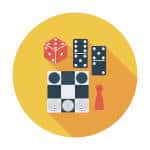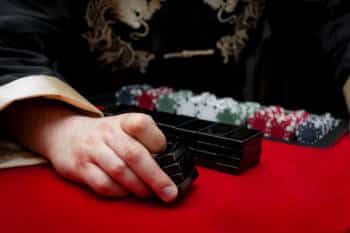 Pai gow is a popular Chinese gambling game played with a set of 32 Chinese dominoes. It’s played all over the world at casinos and online, though the name sometimes refers to the card game pai gow poker (double-hand poker).
Pai gow is a popular Chinese gambling game played with a set of 32 Chinese dominoes. It’s played all over the world at casinos and online, though the name sometimes refers to the card game pai gow poker (double-hand poker).
At first glance, a game of pai gow or its rules might appear confusing or overwhelming, but we’re here to help you learn and start playing.
 Not much is known about pai gow’s origin, though it’s said to pre-date both roulette and baccarat. Pai gow roughly translates to “make nine” in English, and it’s thought that the act of scoring through digits, like in baccarat, may stem from this ancient game.
Not much is known about pai gow’s origin, though it’s said to pre-date both roulette and baccarat. Pai gow roughly translates to “make nine” in English, and it’s thought that the act of scoring through digits, like in baccarat, may stem from this ancient game.
Pai gow is said to be one of the hardest games to learn how to play due to the ranking of all 16 pairs of tiles. It’s also similar to the poker game of the same name, which sees both the player and banker make high and low hands before competing against each other.
We’ll also note that the game is played with a set of 32 Chinese dominoes which are NOT the same as an ordinary pack of dominoes. You cannot play pai gow with a set of regular dominoes.
Pai gow features anywhere between two to eight players. All 32 tiles are shuffled and arranged into eight face-down stacks of four tiles each, this is called the woodpile. Players place their bets and one player is selected to act as the dealer, though in some games the act of being the dealer is rotated along the group.
Each player and dealer will then be given four dominoes and they will split their tiles into a low hand (front hand) and high hand (rear hand) made of two dominoes each. If the player’s front hand beats the dealer’s, and if the player’s rear hand beats the dealer’s, the player wins the bet. If the player’s front and rear hands lose to the dealer’s, then the player loses the bet. If one of the player’s hand wins and the other loses, the player is said to push, which means they neither win nor lose.
Just like baccarat, the value of the two dominoes are added together but if it exceeds nine, the 10 is dropped. So, a hand of 4:3 (Four at the top of the domino and three at the bottom) and 5:5 would normally equal 17, but the 10 is dropped in pai gow, bringing the actual total to just 7. And just like baccarat, a hand equaling nine is the best in the game.
 Each tile combination has a name, and this is where the game can get very complicated for new players. For example, a tile with a 1:1 is called a Day. Meanwhile, a tile with a 6:6 is called a Teen. If either of these tiles is played with a domino worth eight, such as 3:5 or 4:4, the total is 10, called a Gong, and beats nine.
Each tile combination has a name, and this is where the game can get very complicated for new players. For example, a tile with a 1:1 is called a Day. Meanwhile, a tile with a 6:6 is called a Teen. If either of these tiles is played with a domino worth eight, such as 3:5 or 4:4, the total is 10, called a Gong, and beats nine.
Tiles with 1:2 and 2:4 on them are called Gee Jong tiles and can sometimes be called wild cards because they make the values of 3 or 6.
A domino with 4:4 is known as Yun, a domino with 1:3 is known as a Gor or Ngor. Meanwhile, a domino with 5:5 is called a Mooy.
A 3:3 domino is called a Chong, a 2:2 domino is referred to as a Bon and 5:6 dominoes are called Foo. In addition, 4:6 dominos are Ping, dominoes with 1:6 are a Tit, and 1:5 dominoes are called Look.
The game also features 3:6 and 4:5 dominoes called Chop Gow, 2:6 and 3:5 dominoes called Chop Bot, 2:5 and 3:4 dominoes are referred to as Chop Chit and 1:4 and 2:3 dominoes are called Chop Ng.
You may have noticed that some of the dominoes feature coloured spots, however, these are mostly for decoration and have no outcome on the ranking or value outcome.
Pai gow tiles is sometimes confused with the poker version of the same game called pai gow poker. While the games are somewhat similar, they are played differently as the poker version is played with cards rather than dominoes.
The main objective of pai gow poker is to beat the banker represented as the casino or another player. Players are dealt seven cards which are split into a five-card hand and a two-card hand. The five-card hand must rank higher than the two-card hand to win the game, the player’s hands must rank higher than the banker’s. However, if one of the player’s hand ranks higher than the banker’s but the other loses, it becomes a push and the player neither wins nor loses.
Bo: The term for the matched ranking pairs in a game of Pai Gow.
Gong: Hands which are worth more than nine points, traditionally considered to be worth 10 points.
Wong: Hands with a higher value than Gongs, traditionally considered to be worth 11 points.
Woodpile: The starting stack of tiles for a game of Pai Gow, arranged into eight stacks of four tiles.